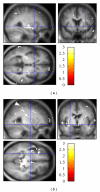A perfusion MRI study of emotional valence and arousal in Parkinson's disease
- PMID: 21969917
- PMCID: PMC3182403
- DOI: 10.4061/2011/742907
A perfusion MRI study of emotional valence and arousal in Parkinson's disease
Abstract
Background. Brain regions subserving emotion have mostly been studied using functional magnetic resonance imaging (fMRI) during emotion provocation procedures in healthy participants. Objective. To identify neuroanatomical regions associated with spontaneous changes in emotional state over time. Methods. Self-rated emotional valence and arousal scores, and regional cerebral blood flow (rCBF) measured by perfusion MRI, were measured 4 or 8 times spanning at least 2 weeks in each of 21 subjects with Parkinson's disease (PD). A random-effects SPM analysis, corrected for multiple comparisons, identified significant clusters of contiguous voxels in which rCBF varied with valence or arousal. Results. Emotional valence correlated positively with rCBF in several brain regions, including medial globus pallidus, orbital prefrontal cortex (PFC), and white matter near putamen, thalamus, insula, and medial PFC. Valence correlated negatively with rCBF in striatum, subgenual cingulate cortex, ventrolateral PFC, and precuneus-posterior cingulate cortex (PCC). Arousal correlated positively with rCBF in clusters including claustrum-thalamus-ventral striatum and inferior parietal lobule and correlated negatively in clusters including posterior insula-mediodorsal thalamus and midbrain. Conclusion. This study demonstrates that the temporal stability of perfusion MRI allows within-subject investigations of spontaneous fluctuations in mental state, such as mood, over relatively long-time intervals.
Figures



References
-
- Weintraub D, Comella CL, Horn S. Parkinson’s disease—part 1: pathophysiology, symptoms, burden, diagnosis, and assessment. American Journal of Managed Care. 2008;14(2):S40–S48. - PubMed
-
- Richard IH, Kurlan R. Anxiety and panic. In: Factor SA, Weiner WJ, editors. Parkinson’s Disease: Diagnosis and Clinical Management. New York, NY, USA: Demos Medical Publishing; 2008. pp. 179–188.
-
- Black KJ, Pandya A. Depression in Parkinson’s disease. In: Gilliam FG, Kanner AM, Sheline YI, editors. Depression and Brain Dysfunction. Oxon, UK: Taylor & Francis Group; 2006. pp. 199–237.
-
- Kawamura M, Kobayakawa M. Emotional impairment in Parkinson’s disease. Parkinsonism & Related Disorders. 2009;15(1):S47–S52. - PubMed
-
- Hillier A, Beversdorf DQ, Raymer AM, Williamson DJG, Heilman KM. Abnormal emotional word ratings in Parkinson’s disease. Neurocase. 2007;13(2):81–85. - PubMed
Grants and funding
LinkOut - more resources
Full Text Sources
Miscellaneous

